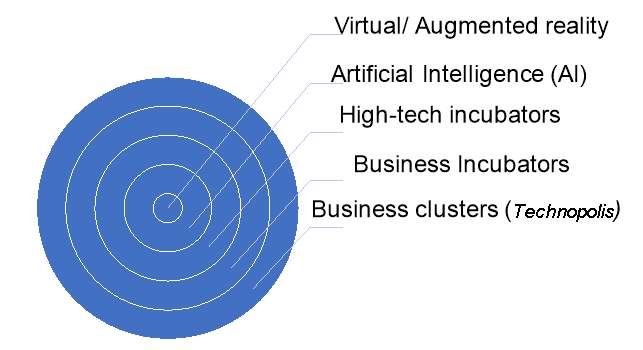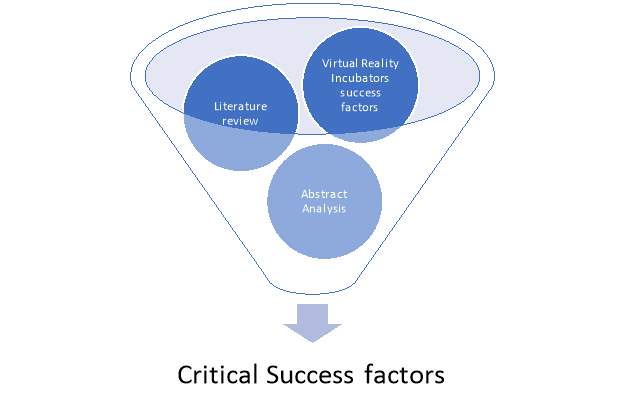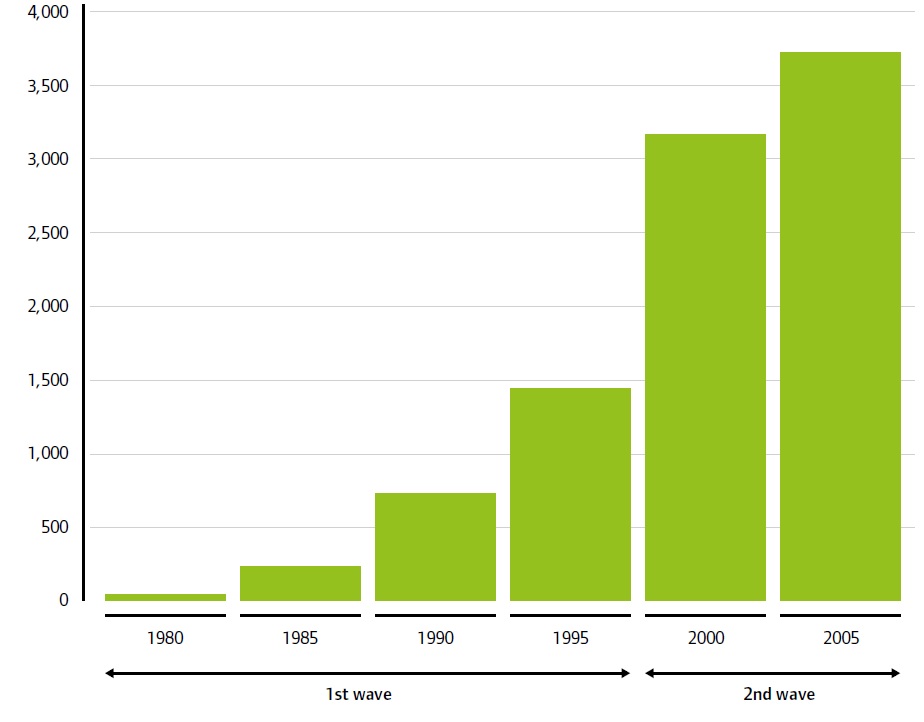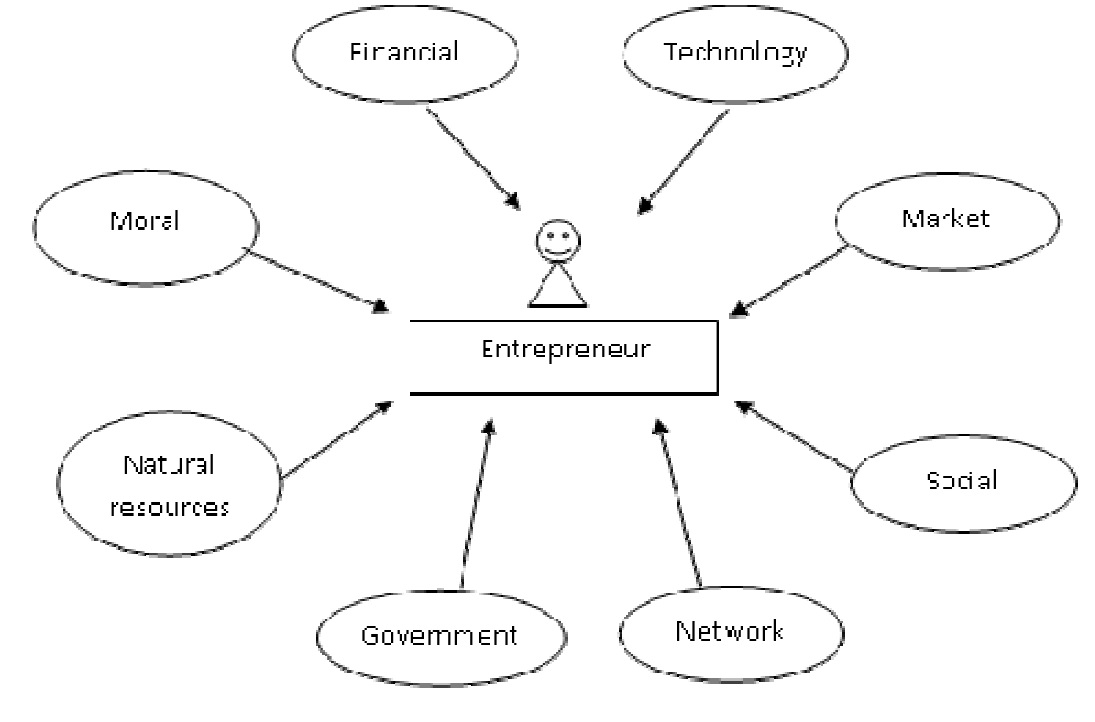Development of High-Tech Business Incubator
Info: 7373 words (29 pages) Dissertation
Published: 10th Dec 2019
Tagged: BusinessTechnology

UNIVERSITY OF BRIDGEPORT
TCMG 645-6W1: TECHNOLOGY NEW VENTURE CREATION
How to Set Up a Successful High-Tech Business Incubator –
Requirements, and Critical Success Factors with case study
SUBMITTED TO:
Professor Naser Sheikh SUBMITTED BY:
Mahmoud Morshedy
Contents
TCMG 645-6W1: TECHNOLOGY NEW VENTURE CREATION
7. Universities / Research Institutes
Influencers and support networks
Critical Success Factors (CSF) / Criteria
Effective Infrastructures (Tavoletti, 2013)
Access to professional facilities
Matrices, Key performance indicators (KPIs)
Keeping talents/talents acquisition
Keep Market Forces Out of the Incubator (Tavoletti, 2013)
Allen Institute for Artificial Intelligence (AI2)
A different definition of business incubation.
Assessment using STEEP perspectives
Figure 1 Entrepreneurship ecosystem layer diagram
Figure 2 Incubators effectiveness
Figure 3 A Systematic Literature Review of Business Incubation
Figure 4 The Technopolis Wheel (R. W. Smilor et al., 1988)
Figure 6 Conceptual Framework of Entrepreneurial Ecosystem (Suresh & Ramraj, 2012)
Figure 7 Evaluation model (Bergek & Norrman, 2008)
Figure 8 Technopolis (Modified, (R. W. Smilor et al., 1988)
Table 2 Standardized ranking of business incubation objectives (%)
Keywords
Business incubators entrepreneurship ecosystem Knowledge-intensive Innovation Process New product development innovation for growth open innovation enhancing idea generation through collaboration business incubation success factors
Motivation for study
The motivation for this paper is to help, the newly birthed, student entrepreneur center (SEC) at the University of Bridgeport. Connecticut is a promising state within the New England area for startup firms. Yet, entrepreneurial initiatives led by universities’ professors to spread the entrepreneurial spirit over the state’s students, and young professionals has not fulfilled its goals. Thus, a study of the entrepreneurship ecosystem and find out the critical factors for a successful incubation process would help their effort.
Research Methodology
This paper was written based on a review of academic literature, industry reports, and articles of the business incubation. As Business incubators are a part of the entrepreneurship ecosystem, reviewing the literature necessitates include literature relating to the innovation and entrepreneurial ecosystem within the research.
Purpose
This paper reviews literature of High-Tech business incubators and technology clusters. The paper’s objective is twofold; first, summarizes literature that provides the requirements for building a technology business incubator and helps to sustain it. As The high-tech industry has a distinct life cycle (Ziemer II, 2012). Thus, the second objective is to define the critical matrix that business incubation stockholders should provide to build a successful business incubator that supports the development of knowledge-intensive businesses.
Introduction
Business cluster defined as (Fieldsteel, 2013).

Figure 1 Entrepreneurship ecosystem layer diagram
This paper focuses on the critical success factors needed to build a High-tech based business incubator for Augmented/ Virtual reality technologies. In addition, we provide two business incubators as successful case studies. Case studies we also planning to conduct expert judges through a survey as a future work.
Critical success factors include:
Such research is effective in addressing the dimensions business incubator to support startups with the tools needed innovation process in this technology evaluations. The conclusion delivers an overall framework as well as criteria desirability gaps. This model is useful for assessing Augmented/ Virtual reality technologies from varying worldviews such as the startups, incubators, investors, as well as policymakers. This model can also provide guidance to decision makers and practitioners on areas of improvement for a selected technology. The paper discusses Boston incubator, healthcare accelerator as two. Allen Institute for Artificial Intelligence (AI2) provide incubation services to the artificial intelligence ideas
Figure 2 Incubators effectiveness
successful case studies.
Literature review Background

Figure 3 A Systematic Literature Review of Business Incubation
| Title | Author | Journal | Year | Highlights | |
| Assessment of Solar Photovoltaic Technologies Using Multiple Perspectives and Hierarchical Decision Modeling |
Sheikh | 2013 | |||
| Business Incubators: Effective Infrastructures or Waste of Public Money? Looking for a Theoretical Framework, Guidelines, and Criteria | E. Tavoletti | Journal of the Knowledge Economy | 2013 | ||
| (Fieldsteel, 2013). | |||||
This is a good example about the methodology and how the literature been reviewed in
A Systematic Review of Business Incubation
2. Methodology for identifying articles for review (Hackett & Dilts, 2004)
Entrepreneurship ecosystem
Past decades the necessity to generate new ideas had proven the importance of developing the Innovation as essential skill into the educational systems. Education systems are the best place where to start introducing the innovation process. Innovation is an essential part contributing to building a successful the entrepreneurship ecosystem (Collins, 2015). However, ecosystems success factors are different from one to another depending on the industry nature. An industrial ecosystem may need manufactural design skills. While the software industry ecosystem may need more software design and computer engineering skills. Ahmed where introducing the idea that the successful entrepreneurship ecosystem and business incubators are exposed to a business cluster where universities contribute to the research (Collins, 2015)(Fieldsteel, 2013).
Entrepreneurship ecosystem consists of policies and practices makers, as well as institutions. The business clusters area the framework where the entrepreneurship works. Technopolis another term used interchangeably with Technology Clusters. Technopolis are networks of stakeholders exits locally or regionally to form a group of entities with a single interest. These group may consist of start-up businesses, investors, universities, research institutions, as well as the government (Fieldsteel, 2013) focused on a specific industry.
Technopolis is a major contributor to Entrepreneurship Ecosystem. (R. W. Smilor, Gibson, & Kozmetsky, 1988) introduced the Technopolis Wheel as a conceptual framework to present the different parties structuring the technology clusters.
Smilor et al. built a model based on the contribution of each segment. University and research institutes provide the technological know-how that startups need. However, the model differentiates between governmental institutes, local, state and federal. Support groups that considered as entrepreneur’s provider and play an essential role to spread the entrepreneurial spirit and enraptures that a keystone to maintaining the entrepreneurship ecosystem. In addition, Smilor et al. introduce the large corporations and emerging companies as a contributor to creation and maintenance of new emerging technologies.

Figure 4 The Technopolis Wheel (R. W. Smilor et al., 1988)
There is two main iconic example which is the Silicon Valley. In addition, Boston’s Massachusetts clean technology cluster which considered as third strongest in the US (Saha, D., & Muro, M., 2017, May 31).
Innovation is about producing a new idea (Gwartney et al., 2000). Introducing a new idea is the core of the innovation process. Converting the idea into a product is the next phase. however, the producing a new idea may be new to the firm produces it (Rogers, 2004). Innovation ideas need time to grow and convert to a stable business. Startup firms work on the type of intensive knowledge ideas have different challenges and opportunities. Thus, successful technology-oriented business incubators focus only on a specific technology and supply startup firms with the needed customized support. During the
characteristics of the Knowledge-intensive high-tech startups. (Ziemer II, 2012)
Business assistance programs are designed to hatch new startups and help them to grow and sustain. Such collaborative programs help people solve problems associated with launching a startup by providing a space to work, seed funding, mentoring, training, and other benefits. Incubators differ from accelerators in a number of ways (Fieldsteel, 2013). Business assistance programs are listed based on the value they add to the startup firms.
1. Angel investor
2. Technology Parks
3. Science Park
Association of Science Parks (IASP) defines a science park as: “… an organization managed by specialized professionals, whose main aim is to increase the wealth of its community by promoting the culture of innovation and the competitiveness of its associated businesses and knowledge-based institutions.” To enable these
goals, a science park; (i) stimulates and manages the flow of knowledge and technology amongst universities, R&D institutions, companies and markets, (ii) facilitates the creation and growth of innovation-based companies through incubation and spin-off processes, and (iii) provides other value-added services together with high quality space and facilities. (Akçomak, 2008)
4. Business accelerator
Business or venture accelerators are more hands-on and intense, making use of a kind of boot camp approach to venture creation. (references)
5. Co-Working Spaces
6. Maker Spaces
7. Universities / Research Institutes
8. Business Incubator
Over 50 years since the first incubator establish in New York 1959, business incubators become very popular to achieve socioeconomic goals. Since then, Business incubator definition had been diversified and become wider.
There are many derivative definitions that spun out of business incubation idea. Business incubators defined as “a support environment for start-up and fledgling companies” and (Peters et al., 2004, p. 83) (Theodorakopoulos, Kakabadse, & McGowan, 2014)
Alternatively, National Business Incubation Association (NBIA) provides a definition to the business incubation as “a business development process that cultivate startup firms, help them to survive and provide management assistance, access to financing, and offer shared office space services”.(Akçomak, 2008).
Business incubators model and their associated services delivered to the incubated firms are derived from objectives set to business incubators. Business incubators objective is varying depending on their stockholders; create new jobs, regenerate cities and regions economy, diversify local economies, commercialize new technologies, fill the technology gap between universities and local corporations and strengthen local and national economies in general (Tavoletti, 2013). Thus, they may have many different goals and vary in the way they deliver their services, in their organizational structure and in the types of incubated firms. Different classifications and typologies of business incubation have been identified. Different business incubation categories introduced. However, most common are is probably the one that identifies four main
categories public non-profit incubators (Business Innovation Centre from a
popular EU policy), private independent profit-oriented incubators, university business
incubators, private corporate profit-oriented incubators.
The most effective is probably the one that identifies four main categories (Tavoletti, 2013) Public non-profit incubators (Business Innovation Centre from a
popular EU policy).
- Private corporate profit-oriented incubators
- University bases business incubators
1. Local Economic Development Incubators
2. Academic and Scientific Incubators
Academic incubator or University-based business incubators are part of the most and due to policymakers, receive public
Academic incubator or University-based business incubators fund from the public and private and they export.
3. Corporate Incubators
4. Virtual incubator
This is an approach to avoid the expenses of establishing an incubator (Tavoletti, 2013)
5. Private Investors’ Incubators
http://www.1000ventures.com/business_guide/business_incubators_4models_byindiaco.html
Setup a Business Incubator
The entrepreneurial ecosystem consists of sectors that contribute to hatch startups. Incubators are part of the ecosystem. They are an element of technology clusters those are forming an industry within a geographical area. Incubators that focus on High-Tech startups are defined within the university sector that supplies the knowledge needed (Fieldsteel, 2013). Incubators that have well-endowed high-quality research team empowers startup firms with a great leap (Fieldsteel, 2013). The number of technology incubators nearly doubled since (Bergek & Norrman, 2008)(Dee, Livesey, Gill, & Minshall, 2011).
Incubators in their early stages of where only provide physical co-working spaces with rental fees below market value (Hackett & Dilts, 2004). However, this concept has been developed. Currently, Incubators meant to facilitate more consultation, and value-added services.
Incubator trends
A rapid growth of the incubator industry towards more specialized business incubators. Business incubators are more focused on specific industries, such as biomedical, industrial design, etc.

Figure 5 Growth of the worldwide incubator industry Source: (Bergek & Norrman, 2008)(Dee, Livesey, Gill, & Minshall, 2011)
Setup requirements
(Suresh & Ramraj, 2012) (R. W. Smilor et al., 1988) proposed network of influencers that impact entrepreneurs’ success. Government represents the policies, university offers the technical knowledge, supporting groups, emerging companies, and large corporations.

Figure 6 Conceptual Framework of Entrepreneurial Ecosystem (Suresh & Ramraj, 2012)
The success of an incubator requires set requirements the ensure its sustainability and fulfills its long-term and short-term objectives.
Incubator objectives
Defining the role of an incubator is essential to outline the success factors of such incubator. Before establishing an incubator, preliminary preparations set up incubator objectives where the performance will be aligned with achieving those objectives as the incubator develops.Long-term successful objectives necessitate a solid sustainability by defining clear and achievable objectives (Verma, 2004) (Fieldsteel, 2013) (Phillips, 2006). Thus, some literatures classify incubators more detailed according to their objective sets (Aernoudt, 2004). (Fernández Fernández, Blanco Jiménez, & Cuadrado Roura, 2015) added a significate analysis for objectives of over than 255 business incubators around the world in table 2.
| Profitable enterprises | 100 |
| Entrepreneurship awareness | 99.6 |
| Job creation | 92.1 |
| Income generation | 66.7 |
| Research commercialization | 63.1 |
| Policy impact | 53 |
| Export revenues | 47.7 |
Table 2 Standardized ranking of business incubation objectives (%)
(Fernández Fernández et al., 2015)
Advisory Board
Building an incubator needs a group of people, management staff to manage the incubator services, network incubated with the industry and support groups. on the other hand, and as a part of the incubator’s objective the selection of the incubatee should be set by the advisory boards and management staff (Theodorakopoulos et al., 2014).
Influencers and support networks
Literature shows that most of the successful business incubators are connected with a network of individuals or organizations officially and non-officially in different ecosystem organizations; industry, academia or even government (R. Smilor, Gibson, & Kozmetsky, 1989). those parties Interconnection usually done by efforts of few influencers. Influencers play the role of magnetic bodies connecting support groups ecosystem. Such leadership role is crucial in entrepreneurship ecosystems to maintain the sustainability of business incubator.(Fieldsteel, 2013).
Value proposition
For a long time, business incubation used as a tool to flourish the economy and generate Jobs (Verma, 2004). However, A Business Incubation is “a process of supporting startup firms and to reduce the chances of failure in early stage” (Network, 2013). Thus, the vitality of incubator value proposition strongly seen on its impact on the incubatee. National Business Incubation Association (NBIA) advice; before starts an incubator, organizers should invest time as much as needed to develop its value proposition. Incubators value proposition is derived from the incubator objectives set earlier. Consequently, the incubator added value could be locally relevant or regionally if the incubator is a part of larger Technopolis.
Services offered / Operations
• Incubator’s location
• business districts
• University campuses.
• Services’ process of delivery
Business incubators are providing list of services (Fernández Fernández et al., 2015)
Critical Success Factors (CSF) / Criteria
This paper is built to discuss and explore the quality and assess the performance in order to identify the critical success factors for the high-tech business incubator.
It is important to inspect the literature that has been conducted and previous recent researchers approached the high technology spin-offs in the renewable energy technology or biomedical sectors. Yet, after the trending of the Artificial intelligence (AI) technology boom, there are no enough literature focus on needs of the business clusters and its associate multiple contributors (business incubators, policymakers,
stakeholders, research institutes, supporting groups, etc.) in such industry.
Effective Infrastructures (Tavoletti, 2013)
Literature is full of discussions about the Business Incubators (BI). Many of them address the high-tech business incubators and listing their success stories
Abstract There is a wide literature about business incubators (BIs), especially about
successful cases in high tech and knowledge-intensive industries. Despite that, there
is neither a viable integrative theory of effective business incubation nor clear guidelines
about the preconditions for establishing BIs and their management. Such theory
and guidelines are urgently needed because there is increasing evidence in the
literature that, despite many successful cases and public policies supporting business
incubation, most of BIs are not successful at all and serious doubts have emerged
about the general effectiveness of business incubation and the advisability of investing
public money in it. Based on a systematic literature review of the poor and
scattered theoretical knowledge of effective business incubation, general principles
are proposed to decide when a BI should be established and what it should do to be
effective. The research is limited to non-profit BIs whose main goal is regional
economic development as they represent the overwhelming majority of operating BIs.
Many national incubation institutes in US, Germany, EU, and Asian are defined the incubation process.
https://en.wikipedia.org/wiki/Knowledge_intensive_business_services
new venture creation
Many incubators have implied new venture creation as a traditional objective that is being spin-out as a result for the incubation process. (Akçomak, 2008)
Economic development
Many incubators considers their contribution in local or regional economic development as an objective that is being spin-out as a result for the incubation process. (Akçomak, 2008)
Job creation
(Dee, Livesey, Gill, & Minshall, 2011) a common objective to business incubators is to create more jobs.
Many incubators have implied job creation as a traditional objective that is being spin-out as a result of the incubation process. (Akçomak, 2008)
Generate jobs is one of the Incubators’ objects (Verma, 2004)
Access to professional facilities
How to Get Experts to Work Together Effectively (https://hbr.org/2017/05/how-to-get-experts-to-work-together-effectively)
Local / Regional influence (Tavoletti, 2013) (Fieldsteel, 2013)
(a) the Incubator Location, (b) Ventures Selecting (c) Coaching and Supporting groups. (a) A region needs to have a sufficiently large population and advanced economy in order to reach agglomeration
economies and host a business incubator [7] (why I do not see that necessary. More citation to critic this idea is needed). It must also possess a strong university
or other research-oriented organization in the region [42]. Of course, these factors are
not sufficient to ensure the expected outcomes [1] and are mediated by the facility
management [42] and external linkages that develop between business incubators
and other regional and national networked organizations that support entrepreneurship
and innovation [9, 22]: ‘Due attention will have to be given to the specific
context and circumstances’ in order to ‘avoid the trap of methodological and theoretical
fundamentalism’ ([9], p. 286) so that the success of a business incubator
depends on the regional innovation system and the general regional environment and
what might or might not occur is contextually determined because ‘business incubators
are idiosyncratic reflections of local conditions’ ([2], p. 74) and a management
practice that is effective in one place may not be effective in another. As an exception
to this general rule, some outcomes will, in spite of context, lead to minimal performances,
while others will reflect the potential of context and offer spectacular success
stories, depending on different histories and chain of events [27]. However, success
stories are not very likely to reoccur in other regions
Value proposition
Incubators have a common value is to provide a supportive environment where startup firms can raise and sustain.
Success measurement has many ways. Different tools define, measure and monitor the success.
Here is list of success measurements for business incubator
https://hbr.org/2012/10/the-true-measures-of-success
Matrices, Key performance indicators (KPIs)
Analysis
The need to performance indicator to measure the performance compared to objectives set is necessary. However, a well-defined set of roles to quantify the success of new ventures is rare to exist and agreed on a wide range.(Dee et al., 2011)

Figure 7 Evaluation model (Bergek & Norrman, 2008)
Upon completing incubation program, a startup expected to able to compete in the global markets and have at least a minimum viable product (MVP), stable team, and basic company departments.
The KPIs are used to impact index are:
- Performance –
- Comparatively benchmark your center’s performance across a broad range of program models, performance metrics and demographics
- Reporting –
- Develop custom performance reports for your investors and stakeholders based on a robust national dataset
- Marketing
- Incorporate validated impact data in your marketing campaigns
- Industry Trends –
- Identify new models and trends in entrepreneurial ecosystems
- New ventures
- Numbers
- Quality (Credibility: association with the incubator tends to lend credibility to a business in the eyes of customers, investors, and peers

Figure 8 Technopolis (Modified, (R. W. Smilor et al., 1988)
The following deification provide of different type of classification for the business incubation. Thus, we can put our imagination about the new classification for the incubation or entrepreneurship ecosystem.
(Hackett & Dilts, 2004) There are several sources of definitional ambiguity. First is the diffusion and repeated adaptation of the original business incubator concept in order to fit varying local needs and conditions (Kuratko and LaFollette, 1987). Second is the interchangeable manner in which the terms ‘‘Research Park,’’ ‘‘Technology Innovation Center,’’ and ‘‘Business Table I Overview of incubator-incubation literature Research streams Characteristics Incubator Development studies Incubator configuration studies Incubatee development
Incubator’’ are used in the literature (Swierczek, 1992).9 Third is the emergence of virtual incubators (also referred to as ‘‘incubators without walls’’) that endeavor to deliver business assistance services to incubatees who are not collocated within the incubator.10 Fourth is a persistent tendency to not define the incubation process, or—when defined—to disagree on where and with whom the incubation process occurs.
A new vision of entrepreneurship ecosystem.
As the “Incubators as tool for entrepreneurship promotion” (Akçomak, 2008)
Stated that
One can categorize incubators either according to their funding scheme (sponsors) (e.g., Becker and Gassmann, 2006) or according to their main objectives (e.g., Aernoudt, 2004).
Funding/sponsor investors
- Angel investor
- For-profit investor
- etc.
Business incubators
- Entrepreneurship Center
- Innovation center
- Private corporate profit-oriented incubators
- public non-profit incubators
- University-based business incubators
- Corporate Incubators
- Virtual incubator
Private Investors’ Incubators
- private independent profit-oriented incubators
- private corporate profit-oriented incubators
- entrepreneurship
Business clusters / Technopolis
technology parks
business accelerators
policymakers
Services provided
Services provided to the incubated firms. Notably that the size of the incubator matters. As the services provided are directly correlated with the number of the incubated firms.
Table 3 shows Provision of services in incubators according to the incubator size (Fernández Fernández et al., 2015)
Provision of services in incubators according to the incubator size (%).
Services provided
Incubator size (no. of incubated firms)
1–5 6–10 11–15 16–20 21 and more Average
Facilities 86.8 91.3 94.6 76.9 72.3 84.38
Business development 77.6 87.0 81.1 69.2 80.9 79.16
Finance 72.4 82.6 94.6 73.1 68.1 78.16
Networking 63.2 76.8 73.0 69.2 70.2 70.48
Technology transfer 52.6 55.1 64.9 57.7 55.3 57.12
Internationalization 46.1 49.3 56.8 46.2 51.1 49.9
Keeping talents/talents acquisition
Let’s see if this reference can help in building this section (Ziemer II, 2012)
Job creation
(Dee et al., 2011) a common objective to business incubators is to create more jobs.
The importance of networking
Smilor et al. show “the importance of networking across the seven segments of the Technopolis wheel; that is, the ability to link public and private sector entities, some of which have been traditionally adversarial, to effect change.19 Finally and perhaps most importantly, are key individuals, or influencers, who link the seven segments of the wheel.”20
Keep Market Forces Out of the Incubator (Tavoletti, 2013)
A business incubator must be a ‘space protected from market forces’ intended to promote the growth of ‘weak-but promising’ ventures so that introducing market criteria inside the incubator (such as
selecting the strongest ventures or the one that would pay higher rents or the ones that
would be selected by private ventures in the market or the ones that operate in more
secure markets, such as accounting firms, legal firms or traditional testing labs)
increases the static efficiency of the incubator [20] but decreases its dynamic efficiency
and moves it away from its goals. This principle is only partially present in
Maital et al. [30] as they conceive it as a ‘paradox of market emulation’ or a trade-off
between the need to imitate markets in order to increase efficiency and the need for
shield new ventures from markets in order to protect them, whereas I conceive it as
keeping the market out of the incubator in order to promote dynamic efficiency
instead of static efficiency: ‘A system—any system, economic or other—that at every
point of time fully utilizes its possibilities to the best advantage may yet in the long
Cases study
Allen Institute for Artificial Intelligence (AI2)
Conclusion
A different definition of business incubation.
The literature on business incubation effectiveness suffers from several deficiencies, including definitional incongruence, descriptive accounts, fragmentation and lack of strong conceptual grounding. Notwithstanding the growth of research in this domain, understanding of how entrepreneurs and their businesses develop within the business incubator environment remains limited. Given the importance of relational, intangible factors in business incubation and the critical role of business incubation management in orchestrating and optimizing such factors, it is suggested that theorizing efforts would benefit from a situated perspective.(“What Matters in Business Incubation ? A Literature Review and a Suggestion for Situated Theorising,” 2014)
Technology matters
literature shows that university-based incubators are the most technology incubators success (reference). Literature indicates that university-based incubators or incubators with research institutes empowered with technology advantage that startups
need (O’Neal, 2005).
Future work
We conduct a further analysis. Quantitative analysis through survey experts and running an SOWT / PESTEL analysis. for further better survey quality, we will conduct an qualitative analysis using triangulation technique.
Assessment using STEEP perspectives
- Social
- Technological
- Economical
- Environmental
- Political
Qualitative analysis
Expert judges survey
Quantitative analysis
Expert judges questionnaire
References
There are no sources in the current document.
Aernoudt, R. (2004). Incubators: Tool for entrepreneurship? Small Business Economics, 23(2), 127–135. https://doi.org/10.1023/B:SBEJ.0000027665.54173.23
Akçomak, I. S. (2008). Incubators as tool for entrepreneurship promotion in developing countries. UNU-MERIT Research Workshop on Entrepreneurship, Technological Innovation, and Development, (October), 1–33. https://doi.org/10.1093/acprof:oso/9780199596515.003.0010
Bergek, A., & Norrman, C. (2008). Incubator best practise : A framework. Technovation, 28(28), 20–28. https://doi.org/10.1016/j.technovation.2007.07.008
Collins, P. K. (2015). Building a Local Design and Entrepreneurship Ecosystem. Procedia Technology, 20(July), 258–262. https://doi.org/10.1016/j.protcy.2015.07.041
Dee, N. J., Livesey, F., Gill, D., & Minshall, T. (2011). Incubation for Growth, A review of the impact of business incubation on new ventures with high growth potential. Research Summary, (September), 1–53. Retrieved from www.nesta.org.uk
Fernández Fernández, M. T., Blanco Jiménez, F. J., & Cuadrado Roura, J. R. (2015). Business incubation: innovative services in an entrepreneurship ecosystem. Service Industries Journal, 35(14), 783–800. https://doi.org/10.1080/02642069.2015.1080243
Fieldsteel, M. T. (2013). Building a Successful Technology Cluster, (June), 36.
Hackett, S. M., & Dilts, D. M. (2004). A Systematic Review of Business Incubation Research. The Journal of Technology Transfer, 29(1), 55–82. https://doi.org/10.1023/B:JOTT.0000011181.11952.0f
Network, N. E. (2013). Guidelines – Metric & Milestones for Successful Incubator Development, (April), 3–22.
O’Neal, T. (2005). Evolving a successful university-based incubator: Lessons learned from the ucf technology incubator. EMJ – Engineering Management Journal, 17(3), 11–25. https://doi.org/10.1080/10429247.2005.11415293
Rogers, M. (2004). Networks, Firm Size and Innovation. Small Business Economics, 22(2), 141–153. https://doi.org/10.1023/B:SBEJ.0000014451.99047.69
Smilor, R., Gibson, D., & Kozmetsky, G. (1989). Creating the Technopolis: High Technology Development in Austin, Texas. Journal of Business Venturing, 49–67. Retrieved from http://www.sciencedirect.com/science/article/pii/0883902689900335
Smilor, R. W., Gibson, D. V, & Kozmetsky, G. (1988). Cixeating the technopolis: development in austin, texas. Mechanical Engineering, 4(1), 49–67.
Suresh, J., & Ramraj, R. (2012). Entrepreneurial Ecosystem : Case Study on the Influence of Environmental Factors on Entrepreneurial Success. European Journal of Business and Management, 4(16), 95–102.
Tavoletti, E. (2013). Business Incubators: Effective Infrastructures or Waste of Public Money? Looking for a Theoretical Framework, Guidelines and Criteria. Journal of the Knowledge Economy, 4(4), 423–443. https://doi.org/10.1007/s13132-012-0090-y
Theodorakopoulos, N., Kakabadse, N. K., & McGowan, C. (2014). What matters in business incubation? A literature review and a suggestion for situated theorising. Journal of Small Business and Enterprise Development, 21(4), 602–622. https://doi.org/10.1108/JSBED-09-2014-0152
Verma, S. (2004). Success Factors for Business Incubators: An Empirical Study of Canadian Business Incubators.
What Matters in Business Incubation ? A Literature Review and a Suggestion for Situated Theorising. (2014), 1–31.
Ziemer II, N. L. (2012). Strategic management and entrepreneurship as economic development tools. ProQuest Dissertations and Theses, 133. Retrieved from http://search.proquest.com/docview/1314417041?accountid=14745%5Cnhttp://sfx.fcla.edu/usf?url_ver=Z39.88-2004&rft_val_fmt=info:ofi/fmt:kev:mtx:dissertation&genre=dissertations+&+theses&sid=ProQ:ProQuest+Dissertations+&+Theses+Full+Text&atitle=&title=Strate
Saha, D., & Muro, M. (2017, May 31). Clean energy’s shifting reality: Venture capital recedes, but what’s next? Retrieved November 25, 2017, from https://www.brookings.edu/blog/the-avenue/2017/05/30/clean-energy-venture-capital/
Patwardhan, R. (Ed.). (n.d.). Business Incubators: Comparison of Four Different Models. Retrieved October 10, 2017, from http://www.1000ventures.com/business_guide/business_incubators_4models_byindiaco.html
Fred Phillips, Social Culture and High Tech Economic Development: The Technopolis Columns (New York: Palgrave MacMillian. 2006).
Cite This Work
To export a reference to this article please select a referencing stye below:
Related Services
View allRelated Content
All TagsContent relating to: "Technology"
Technology can be described as the use of scientific and advanced knowledge to meet the requirements of humans. Technology is continuously developing, and is used in almost all aspects of life.
Related Articles
DMCA / Removal Request
If you are the original writer of this dissertation and no longer wish to have your work published on the UKDiss.com website then please:




